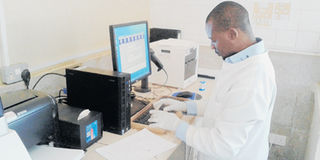Ending Tuberculosis through better diagnostics

What you need to know:
- In Tanzania the prevalence of TB is 295 cases per 100,000 people, and this puts the country among those with a high burden of the infectious disease globally.
- Yet, for over 100 years, diagnosis of TB was heavily dependent on the use of microscopes, known as smear microscopy, using a technique known as Ziehl-Neelsen Stain, whereby bacteria causing TB were seen under the microscopy in their red rod shapes.
Yes, in order to end tuberculosis (TB) in Tanzania, we need better diagnostic tools—especially in this world where the disease is among the most deadly maladies.
In 2015, there were 10.4 million new TB cases worldwide. An estimated 1.4 million people died of the disease.
In Tanzania the prevalence of TB is 295 cases per 100,000 people, and this puts the country among those with a high burden of the infectious disease globally.
Yet, for over 100 years, diagnosis of TB was heavily dependent on the use of microscopes, known as smear microscopy, using a technique known as Ziehl-Neelsen Stain, whereby bacteria causing TB were seen under the microscopy in their red rod shapes.
However, this diagnostic method was not sensitive enough in detecting TB—in fact its sensitivity was estimated to be between 20 and 80 percent, in scientific terms.
When using the smear microscopes, results are obtained in a range of one to seven days depending on the healthcare infrastructure.
Other ways of diagnosing TB include clinical suspicion and a chest X-ray with features suggestive of TB.
In absence of a confirmation through laboratory findings, history taking and clinical examination are often the cornerstones of TB diagnosis.
Unfortunately such approaches are tricky due to the following reasons: TB symptoms are often not specific and chest X-ray does not always show typical features of TB.
Therefore, there is an urgent need for better diagnostics which ideally can confirm results at primary health facilities.
The gold standard for TB diagnosis is using what we call culture medium but this is not available in remote facilities and requires specialized infrastructure and skills.
In peripheral healthcare facilities, there is still no reliable accurate diagnostic tool which is highly sensitive for TB detection.
For example, in 2014, almost 40 percent of the notified TB cases in Tanzania were clinically diagnosed, meaning there was no confirmation of the bacteria causing TB in the patients—the doctors just relied on symptoms.
This does not necessarily mean those clinically diagnosed did not have TB, however, it could have implications with regard to the kind of treatment that the patients would get. This can lead to under- or over-diagnosis.
In 2010, the WHO recommended the use of a novel diagnostic tool known as GeneXpert.
This tool was shown to be very sensitive and highly specific for TB detection and can be used in district and sub-district levels such as at health centres.
Many countries were able to procure it through concessional price and implemented GeneXpert technology in their National TB Programs.
The Tanzanian National TB and Leprosy Program(NTLP) is currently implementing GeneXpert toll in some diagnostic centres.
Efforts are underway to scale up the use of the GeneXpert in the country.
Unfortunately, the use of the tool in resource limited settings encounters a number of challenges.
Proper training in computer skills among the operators was often missing when GeneXpert was rolled out.
Other challenges included unreliable power supply, dust build up and uncontrolled temperatures at places where the instrument was stationed.
While GeneXpert has increased the number TB confirmations and detection of multi-drug resistance TB, it has not shown an impact on reducing deaths caused by TB, morbidity and time spent on treatment compared to smear using microscopy.
In future, new and improved molecular diagnostic tools with high sensitivity like GeneXpert should be rolled out to the lowest level of the health care system.
At that level, this is actually the first point of contact for presumptive TB patients.
A team of scientists from the Ifakara Health Institute (IHI), the Swiss Tropical Tropical and Public Health Institute (Swiss TPH) and the National TB and Leprosy Control Program (NTLP) are now looking into clinical trials that will give birth to tools that are better than microscopy.
The tools are known as Omni combined with Ultra, which will be rolled out under a project supported by the Foundation for Innovative New Diagnostics and the Stop TB Partnership’s TB REACH initiative.
The WHO, through END TB strategy has set global ambitious goals to achieve zero death, disease and suffering due to TB by 2035.
I’m confident that through better diagnostics such as the Omni combined with Ultra, health workers involved in TB diagnosis will be better equipped to use the tools and this would significantly contribute in achieving the ambitious 2035 END TB goal.
The author is a clinical epidemiologist and a research scientist working for Ifakara Health Institute.




